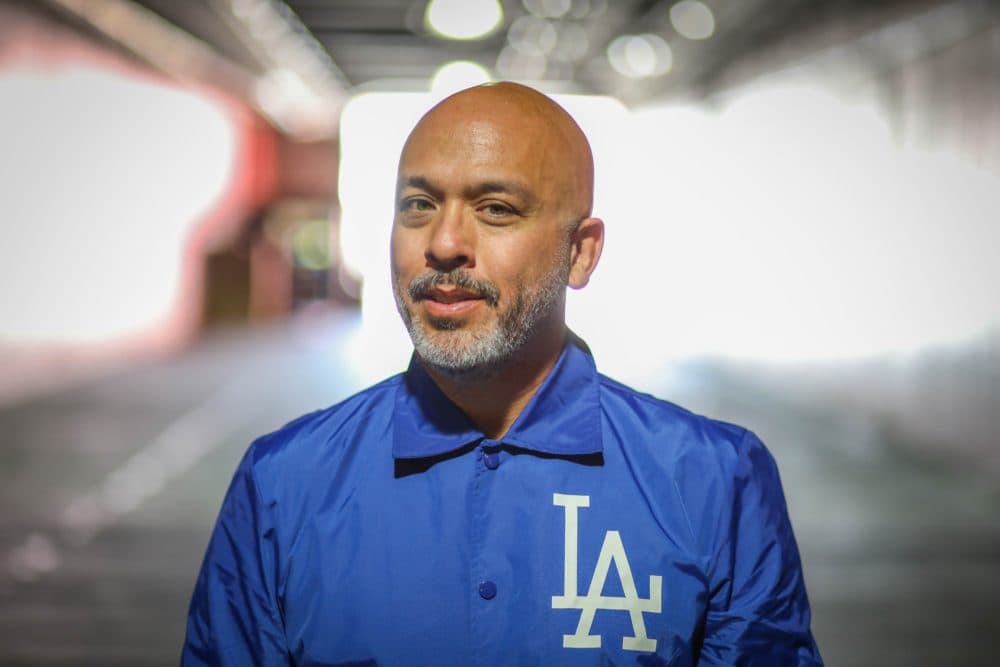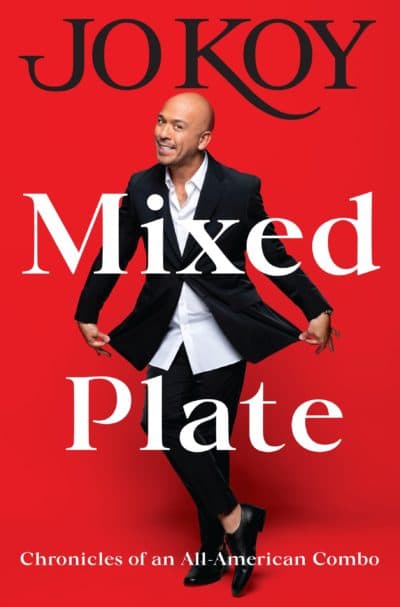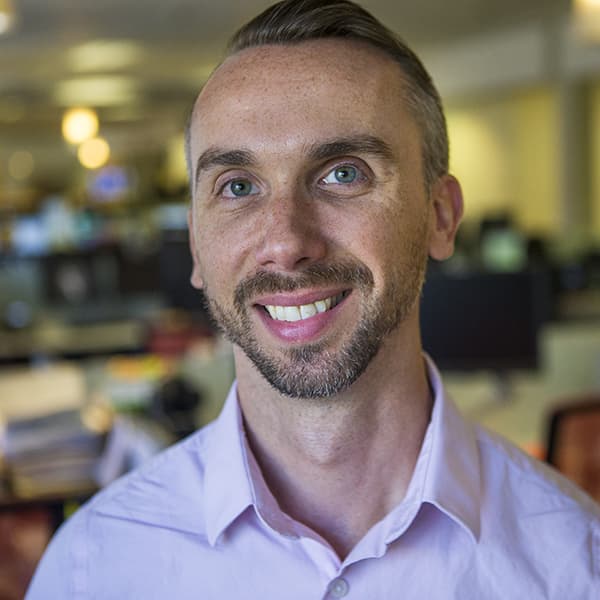Advertisement
Comedian Jo Koy writes about being half-white, half-Filipino and all funny in memoir 'Mixed Plate'

Editor's note: This segment was rebroadcast on April 14, 2022. Find that audio here.
Jo Koy built a successful stand-up career mining his Filipino heritage, with sold-out shows and three Netflix specials.
But Koy writes in a new memoir, "Mixed Plate: Chronicles of an All-American Combo," that growing up as a half-White, half Filipino kid in the 1970s and ‘80s meant dealing with constant racism. After last week’s shootings in Atlanta and attacks against the elderly put a spotlight on anti-Asian violence, Koy says he understands this experience as someone who grew up with a Filipino immigrant mother.
“This is something I've experienced firsthand and always had to keep to myself because you live in a country where it's almost normalized and accepted, where Asian culture tends to be quiet and not really speak up,” he says. “And now we have a generation of people that are speaking up now and defending and letting our voices be heard.”
Koy approaches difficult conversations in a disarming way with humor. But in the book, he writes that it took time for him to feel comfortable incorporating his heritage into his comedy.
Koy’s struggle with identity stems from his white father and Filipino mother divorcing when he was 10 years old. His father moved to another state, leading Koy to cling to his Filipino side.

In one of his Netflix specials, he addresses the stereotype that all Asian people look alike by making a joke about his mom’s quest to find friends in the ‘70s. The reality behind these jokes, he says, is his mother’s struggle to find community during a time of racial tension in the U.S.
“My mom literally had to build up the courage to walk up to people and ask them what they were,” he says. “And that's what that joke is. It's like, yeah, it's funny, but just imagine my mom's struggle at that point.”
Koy and his mom ultimately found a community of Filipino immigrants, but it took a while. And he writes about the jarring childhood experience of living on military bases where he fit in with the other mixed-race children and then moving to a place where he was the only half-Filipino kid in his class at school.
Humor helped him fit in during this difficult time, he writes. Humor allowed him to connect with his peers — who didn’t understand how important his heritage is to him — without having to serve as an ambassador to Filipino culture and food, he says.
Advertisement
“Humor was my escape,” he says. “I had to use humor to try and get who I am as a person out there.”
Koy’s mother is central to his comedy. In one of his specials, he talks about a time he thought he had pneumonia and his mom prescribed Vicks VapoRub as a cure-all for everything. This might have been because, as Koy reveals in his book, money was tight for things like expensive medical treatments.
After Koy begged her, his mother ultimately gave in and made room in the budget for an HBO subscription. He writes about how HBO became something like a textbook, binging stand-up specials and studying comedians.
Seeing how hard his mom worked impacted Koy. The duo connected with other Filipinos at church and started building community, he says, and soon enough they were renting the Knights of Columbus hall next door to throw Filipino events that featured performances from her kids.
“All that stuff was indirectly embedded in me, you know, just watching how my mom made things happen and seeing her grind and her hustle,” he says. “So I took that on. And thank God I did, man, because it helped me a lot.”
Koy later reconciled with his father, who encouraged him to go into stand up when he faced a lot of skeptics. His dad told him to follow his dreams and felt excited to see his son succeed, Koy says.
“I remember my dad said to me, he goes, ‘Don't do what I did. I always wanted to be a pilot. And now, look, I'm still dreaming about being a pilot,’ ” Koy says.
His dad urged him to take his shot and it paid off. And Koy has made an effort to bring others along with him. He filmed his most recent Netflix special in Manila and shared the stage to give other comedians a platform.
“Mixed Plate” explores his struggle breaking into comedy. When he started doing stand-up comedy, he says he was limited to ethnic-themed shows with “horrific names” such as “Asian Invasion” and “Slanted Comedy.”
When Netflix wanted him to make a third comedy special, he decided to showcase Filipino talent.
“I know how hard it was for me to get in here,” he says. “And I just want to provide this one opportunity. You know, I opened up the door and now I want to let others in.”
Much of Koy’s work is based on interaction with the audience. One year into the pandemic shutting down performances in front of live audiences, Koy says he’s excited to feel the energy of fans’ laughter again.
“There's not a drug in the world that can give you the high that live performance gives me,” he says. “When I feel them clapping and cheering and I say ‘good night’ and they stand, man, that's everything to me. And I cannot wait to get back on stage and do it again.”
But Koy makes it clear he’s not hoping he’ll get back on stage soon — he knows he’ll be giving audiences a “beautiful time” again in the near future.
Emiko Tamagawa produced and edited this interview for broadcast with Todd Mundt. Allison Hagan adapted it for the web.
Book Excerpt: 'Mixed Plate'
By Jo Koy
INTRODUCTION
I was walking down the streets of Manila a few months ago, taking it all in.
One block was like something out of a postcard. This gorgeous park with long winding paths, lawns that were the greenest of green, and huge tropical trees like you’d see in a rain forest.
A couple of blocks later, suddenly it was nothing but skyscrapers, fancy restaurants, high-end shopping, and casinos. The kind of energy you might find in Tokyo, Singapore, or any other rich, major metropolis in the world.
A few blocks after that, and it was like I was in a different universe. Unfinished buildings that were nothing but skeletons, no windows, no siding, no nothing. Shanties built out of scrap metal where people lived and sold souvenirs to the occasional tourists who walked by. Mothers washing their naked kids with buckets of water in the middle of the street.
But no matter who I saw, no matter who I talked to, rich or poor—every single person was smiling. Every one of them was full of life and happy.
I lived here forty years ago. Spent a few years on Clark Air Base with my white all-American dad, my Filipina mom, and my brother and sister. Base life is a far cry from the city, and I was young, just nine or ten, but I still remember coming to Manila to shop on weekends, the streets looking almost the same as they do now. And I’ve been back to visit a thousand times since then, see- ing my family, bringing my son to learn about his roots.
But this time—this time was different.
This time I was here to shoot my third comedy special for Netflix—my third! I wasn’t some struggling LA comic who worked three jobs on the side and could barely pay his rent. I was living the American dream.
I sold out massive arenas everywhere I went. I owned a house in the Hollywood Hills. My son was about to graduate from private school. He didn’t have to scrounge for spare change to get lunch from a vending machine like I did when I was a kid—he had a fancy debit card to buy f***ing filet mignon in his cafeteria!
I used to worry about what other Americans would say when I told them I was Filipino, how they’d respond, how they might judge me. TV networks turned me down over and over again, say- ing my story was too “ethnic” and white people wouldn’t “get it.”
Now I was being paid by the biggest platform in entertainment to shoot a special in the Philippines about the Philippines. I was gonna tell my own mixed-up, mixed-plate story, I was gonna show off my culture to the world—and I was getting rich doing it.
In all the ways I’d ever hoped, I’d made it. And yet, even as I walked down the streets of my childhood with a film crew follow- ing along, even as I realized just how much I’d accomplished, deep in my mind I could still hear my mom the very first time I told her I was gonna be a comic.
“What? Josep, you want to be a clown? Is that what you’re telling me, Josep? Ha? You want to make your living being a clown??” Yeah, Mom. A clown. That’s what I want to be.
As I built my career, she kept coming at me with those same doubts, those same questions constantly. Swear to God, to this day she thinks I should get a management job at Macy’s so I can lock down some decent benefits.
And that’s why I’m writing this book. Because after all this time, all my struggle and sacrifice, my mom still doesn’t really understand.
Not just my mom, either. Friends, family, fans—it’s hard for people to understand what it means to be successful as a comic, especially when you come from such a different place, such a difficult background.
In a way, it should be hard for people to understand. When
I get up there onstage in front of a thousand people, I have one goal—to make them laugh. To help them have fun and escape all their problems, even if it’s just for a few hours.
I want them to be dazzled by the lights and electrified by the music. I want them to connect with my stories and my voices and my characters. I want them begging for more.
I don’t want them to leave my show being like, “Oh man, the depths of your pain and heartache, f***!” I want them to cheer, “Bro, you killed it! I never laughed so hard in my f***ing life!”
I love to make people laugh. I live for it. I have since I was a little kid.
But when I tell my jokes about white people not knowing “what I was” when I was little, when I talk about my mom driving me crazy or my sister getting kicked out of our house or my stepdad making cracks about Asians eating rice—as funny as that shit is there’s real emotion behind it, too. Real conflict. Real darkness.
I hint at it in my act. If you’re paying attention, it’s there. And I actually think that that emotional honesty is a big reason why so many people from so many cultures relate to my stories.
But I never really opened up about my mom’s constant judgment, about my dad leaving us, about my brother’s violent schizophrenia, or about my own struggles to be a good father to my son. I never really opened up about how hard it was growing up as a half-breed Filipino in suburban America. I never really opened up about all the barriers I had to overcome in the racist entertainment industry as I built my career brick by brick and show by show.
I never really opened up—until this book.
Walking through the streets of the Philippines, this place I’d once so briefly called home but which held the key to so much of who I am, it hit me that it was a land of contradictions.
If you stick to one area, you might think it’s the most perfect, most pristine country in the world. Push a little farther, go a little deeper, and you find the poverty, the struggle, the pain. But underlying it all there’s a joy, a laughter, a loving spirit that can’t be broken.
There’s something beautiful about that. Something magical. Something universal. Something that always makes me want to come back for more.
I hope you’ll find some of that same magic here, in my book.
And that you’ll be laughing your ass off along the way.
From MIXED PLATE by Jo Koy Copyright © 2021 by Jo Koy. Reprinted by permission of Dey Street Books, an imprint of HarperCollins Publishers.
This segment aired on March 23, 2021.

